Halma has released a trading statement ahead of its financial year end on 31 March 2024. Revenue growth, ignoring exchange rates, has been “strong” and reflects a mix of organic growth and acquisitions.
Eight acquisitions have been completed so far this financial year, with a total cost of £299mn.
Halma continues to expect full-year underlying profit before tax in the range of £376.0mn to £393.5mn, with a consensus among analysts of £388.5mn. Cash conversion (how much accounting profit is backed by cash flows) is expected to be ahead of the 90% target.
The shares were broadly flat in early trading.
Our view
Halma’s full-year trading update contained no real surprises. Performance is in line with expectations which points to organic revenue growth above 5.0% and around 7.6% growth in underlying pre-tax profit.
Halma's essentially a mash-up of around 45 businesses working to provide technology solutions in the safety, health, and environmental markets. This differentiated business model, geared toward non-discretionary and sustainability related demand, offers exposure to some resilient long-term growth drivers. These include increasing demand for healthcare, tighter safety regulations, and growing global efforts to address climate change, waste and pollution.
Halma has shown itself to be a safe pair of hands, the current year being its 20th consecutive year of record profit. This provides some comfort that it can prosper even in a challenging economic environment, but there are no guarantees.
Acquisitions are key to the strategy, so cash conversion (the level of operating profit backed up by cash) is essential. Following a brief dip in the first half of last year, things look to have bounced back and we should see it above the 90% target this year. One of the first things we look at in a buy-and-build business model is its ability to throw off cash flow. Buying businesses isn't cheap; it's much more sustainable if it can be funded by internally generated cash.
Progress on deals over the year has lagged last year's record levels. After a slow first half, spending just £60mn, there was more activity in the second. But a total spend of £299mn this year still lags the £400mn spent last year. We don’t want Halma to buy for the sake of it, but having a healthy pipeline of deals and being able to execute is key.
Net debt more than doubled last year, but still looks manageable at 1.4x cash profit last we heard. Add in good cash flow, and there's plenty of room for investment should the right opportunities arise.
All in, we're supportive of Halma's business model and growth drivers. But we aren't alone, and while the valuation has come down from its pandemic highs, it's still towards the top of its peer group. There's plenty of pressure to deliver.
Halma key facts
All ratios are sourced from Refinitiv, based on previous day’s closing values. Please remember yields are variable and not a reliable indicator of future income. Keep in mind key figures shouldn’t be looked at on their own – it’s important to understand the big picture.
This article is not advice or a recommendation to buy, sell or hold any investment.No view is given on the present or future value or price of any investment, and investors should form their own view on any proposed investment.This article has not been prepared in accordance with legal requirements designed to promote the independence of investment research and is considered a marketing communication.Non - independent research is not subject to FCA rules prohibiting dealing ahead of research, however HL has put controls in place(including dealing restrictions, physical and information barriers) to manage potential conflicts of interest presented by such dealing.Please see our full non - independent research disclosure for more information.


